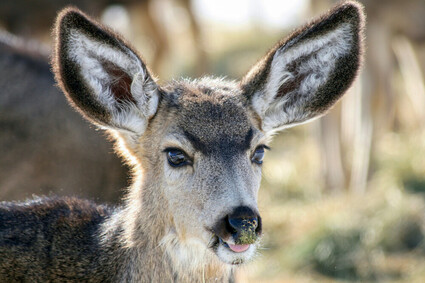Mule deer census raises concern
Last updated 4/18/2023 at 6:15pm

Photo courtesy ODWF
Mule deer - named for their big ears - are an iconic part of the Sisters Country landscape. New rules may be created to preserve their habitat and populations.
Mule deer populations, their habitat, and how to handle them is a big question in Sisters Country.
The Deschutes County Community Development Department held an informational meeting last Wednesday at Sisters High School. They were pleased - and surprised - at the turnout. "Over 100," according to Department Head Peter Gutowsky, who along with two department staff and ODFW (Oregon Department of Fish and Wildlife) Biologist Andrew Walsh made a formal presentation aided by slides.
Only 50 chairs were set out, and a scramble ensued to find another 50 as the room kept filling.
The audience, made up almost exclusively of Cloverdale and surrounding rural property owners, listened intently, especially to the remarks of Walsh, who discussed in detail with accompanying photos and graphics how his department count mule deer and other species.
Oregon is seeking to protect what is perceived to be a declining number of deer. The County's interest has been ongoing for almost 30 years, Gutowsky told The Nugget. The last wildlife inventory was taken in 1992.
Gotowsky's department is initiating a process to create a new mule deer combining zone and a corresponding new code chapter to address uses in that zone. For rural properties under 20 acres with an existing home, generally no changes are being considered.
"The purpose of the project is to conserve important mule deer winter range habitat in Deschutes County; to protect an important environmental, social, and economic element of the area; and to permit development compatible with the protection of the mule deer resource," the Department says on its website.
Oregon law does not demand that counties take action such as is being discussed in Deschutes County. Planners say it is necessary to meet the terms of Goal 5 of its Comprehensive Plan.
"Informal conversations have been taking place the last several years among staff and commissioners. Our first serious look at the subject was shaped around a grant we received in 2018 or 2019," Gutowsky explained.
Currently, if your property is in the wildlife overlay zone, you are prohibited from building or operating a golf course, commercial dog kennel, church, public or private school, bed and breakfast, dude ranch, playground, recreation facility or community center, timeshares, veterinary clinic, or fishing lodge.
If your land winds up in the expanded zone, you would likely be restricted in where you could site your home. You could be forced to build no more than 300 feet from the public road. New fences in the wildlife areas would need to be designed to let wildlife pass over or under the fence, which could limit landowners' ability to raise livestock or keep horses.
Gotowsky assumes his department will propose code amendments to the commissioners and expects the proposal will be shaped in significant part by questions and comments expected at its April 13 public hearing. The meeting at the high school was informational only and questions were not encouraged, but accepted, with time at the end of the presentation.
Questions and comments began around 7:30 p.m. and ended formally at 8 p.m., when the meeting agenda ended. However the conversation continued informally for another half hour.
"The questions were probing and respectful," Gutowsky said. One unidentified gentleman in a large cowboy hat - typical of the night's attire - asked: "Who are we to say where deer can roam and eat?"
Many attendees were taking copious notes on pads. The mood was somber with pre- and post-meeting conversation expressing worry that the County would impose restrictions on property owners that either were unworkable or would be costly to the landowner to implement - or both.
Susan Hamlin lives in Cloverdale on 19.47 acres with a home, so is likely exempt from any rule changes.
"My neighbors have 30-plus acres and raise hay," Hamlin said. "They could not be at the meeting, as much as they wanted. They're needing to build a new barn for their horses, who they must now stable off-site. They are uncertain what to do, worried that they may make a big investment and learn later that it might not be in compliance."
Uncertainty was present in the room as attendees, many of whom earn their living off their land, are generally skeptical of land-use impositions.
Gutowsky says he is optimistic that the process and recommendations "will balance the economic, cultural, and environmental impact" of any changes in code. He allowed that the development code is a constant work in progress and can be amended again in the future should circumstances warrant.
The iconic Central Oregon mule deer has seen its population decline by 56 percent between 2004 and 2021 based on an ODFW study, a reduction of about 10 percent a year. The Upper Deschutes Basin is 60 percent below objective ODFW claims. In the Metolius Basin, herds are at 46 percent of objective, the study says.
Reasons vary from development (reduction of habitat) to predation (cougars and perhaps wolves) to disease. Hamlin, like many in Sisters, doesn't necessarily see fewer numbers.
"They're plentiful where I am and help themselves to anything I grow," she said.












Reader Comments(0)